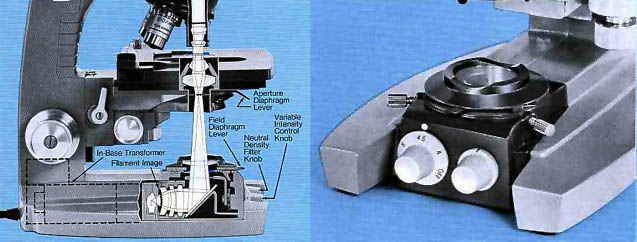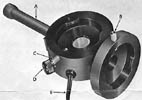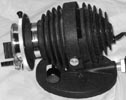

An AO Spencer Bulb Reference
Note: Dave Jackson has contributed a 1955 'Price List for Replacement Lamps and Electronic Tubes used in AO Scientific Instruments' leaflet that gives some detailed information (e.g. wattage, voltage, filament, base, etc.) for all the AO bulbs of that era's microscopes.
Series 10
Tom Woods has kindly created this Guide to the Series 10 illuminators and bulbs.
As to bulb sources, see below
| |
The 1034 or 1037 illuminators use:  15S11/102CLSYLV 15S11/102CLSYLV |
|
The 1036 illuminator uses: GE1460 GE1460 |
Note Tom Woods shares that the GE1631X is a direct replacement for the GE1460 and might be more available. |
|
| Note: AO furnished a special re-lamping tool for the 1036. See here for more detail. | ||
| The 1031 illuminator uses:
|
Here are some equivalent names: AMERICAN OPTICAL 7388 AMERICAN OPTICAL ONE-10 ) AMERICAN OPTICAL 1120 |
|
| Note: AO furnished a special re-lamping tool for the 1031. See here for more detail. | ||
 |
The DualView pointer uses:  |
Here are some equivalent names: GE 328 AMERICAN OPTICAL 1032 |
Have a DualView unit?  Send me an email and I will share it.
Send me an email and I will share it.
External Illuminators
 |
AO CycloSpot External Illuminator | Replacement bulb is:
|
 |
AO Starlite External Illuminator. Cat#s 369V, 363V, 363F, 364, 579, 655, etc. | Replacement bulb is:
|
 |
Is your illuminator of the 'Universal' type? Download the manual for this illuminator here. (courtesy of Gary Bennett) |
Replacement bulb is:
|
 |
AO Starlight Substage Illuminator. Cat #' 609, 610, 612, or
618.
Note: See Stan Ayers' DIY version of this here. |
Replacement bulb is not GE1460, but:  15S11/102CLSYLV 15S11/102CLSYLV |
 |
AO 370 Illuminator | Original replacement bulb may be:
But, my 370 Illuminator has the 602 below and it too appears original -- so I'm not sure what is the real 'original' bulb. Note: This illuminator is famous for being easily converted to use any bulb by changing out the socket. See notes below |
 |
AO 735 Illuminator | Replacement bulb is probably:
Note: As with the 370 above, this illuminator is also famous for being easily converted to use any bulb by changing out the socket. |
| AO Ortho Illuminator | Replacement bulb is probably:
Note: Can be converted to use any bulb by changing the socket. See notes below. |
Have an Ortho Illuminator?
Here's
the manual in pdf format at Gordon's site.
Have a Starlight Substage Illuminator?
 Here
are the instructions.
Here
are the instructions.
Have a Starlight External
Illuminator?  Here's a short note on its use.
Here's a short note on its use.
Have a CycloSpot External
Illuminator?  Here
are the instructions and diagram.
Here
are the instructions and diagram.
Have a Transillumintor Base for your
Cycloptic? Here's
a short note on it.
Series 4
 |
AO Series 4 Microscope Cat# 404 'in-base' illuminator | The catalog states: 15cp, 6V, GE88, but this bulb
has been discontinued. The base requires a double contact,
bayonet (BA15D). The best bet is:
Do not use what is often quoted as GE88's replacement -- OP2118 -- because although the base is correct (again, BA15D, and also 30W, 6V, 5.0 amp) the bulb is too long to fit. |
Series 110
 |
AO Series 110 Microscope illuminator | Replacement bulb is the same as the Series
10, 1031 illuminator above: |
Here are some equivalent names:
AMERICAN OPTICAL 7388 AMERICAN OPTICAL ONE-10 AMERICAN OPTICAL 1120
|
Series 20 and 120

|
AO Series 20 Microscope illuminator | Replacement bulb is:
FCR 100W 12V GY6.35 64625 7023 OSRAM/PHILIPS BRAND HLX64625 for $2.94 a bulb. |
Series 60 and 160
 |
AO Series 60 Cat# 614 in-base illuminator |  15S11/102CLSYLV 15S11/102CLSYLV
|
Series 150
| AO Series 150 Cat# 614A, or 605B, in-base illuminator |  15S11/102CLSYLV 15S11/102CLSYLV
|
|
 |
AO Series 150 Cat# 623 in base illuminator with built-in transformer |  7387 (6V, 10W) 7387 (6V, 10W)
|
Ortholux
| Leitz Ortholux I |
|
Search for sm-8110 on
Google. These bulbs seem to have been discontinued, but pockets of the
are still available at around $12 per bulb. In other words, you
don't need to pay $40 per bulb or higher on eBay
for these :-)
|
| Note: Don't have a suitable
transformer to drive your Ortholux's light?
An AO Cat# 1051 (6v, 5amp, va = 29), or an AO Cat# 655 (6v, 5amp, va = 30) transformer, are perfect for this, and both are readily available on eBay. While the 1051 is just the transformer (used to drive the 1036 illuminator of the Series 10), the 655 comes with a well corrected 'StarLite' illuminator that can be used, in a pinch, in place of the Ortholux lamp housing if need be. Voltage range on the 1051 is 4.5v to 7.5v in steps, which is a little wider range than the 655's 4.6v to 6.0v (again in steps), but either does just fine. I usually run at 5.0 to 5.5v anyway, with 6.0v only needed for DF and Phase at higher powers. Note: Gordon has valuable Leitz microscope manuals, including the Ortholux manual, here at his site. One document he doesn't have yet, but soon hopefully will, is "Image-forming and Illuminating of the Microscope -- objectives, eyepieces, and condensers" (23.4 MB zipped file) |
Notes:
From Needham’s 1958 “The Practical Use of the Microscope”
[p. 312] "American Optical Adjustable Laboratory Lamp, No. 370. This lamp is well designed and compact, being adjustable to a vertical position and the housing slides down nearly to the base for portability. The finest feature of this illuminant is the 60mm diameter, graduated iris diaphragm mounted quite close to the double plano-convex condenser, somewhat unusual for a lamp in this price range. The 100 watt, 130 volt projection Mazda bulb may be correctly adjusted for height and parallelism of the monoplane filament . . .With this type of Mazda projection bulb, ground glass is necessary to secure even illumination with transmitted light . . . for the above reasons the author has substituted an ordinary 60 watt, 120 volt, frosted inside Mazda for the much more expensive and inefficient projection Mazda in the lamp housing".
Note within a note :-): Mazda is an old GE trademark -- not a car. See the 1914 Catalog. The relevant definition, on page 1, says: "There are two classes of lamps mentioned in these schedules: GEM and MAZDA. GEM is a trademark applied to lamps with metallized carbon filaments. MAZDA is a trademark applied to those metal filament lamps which embody the features of material and manufacture deemed best for such lamps by the Research Laboratories of the General Electric Company." See http://www.oldchristmastreelights.com/the_mazda_lamp_story.htm for the fascinating story behind the MAZDA name.
Jim Wheeler writes:
"I was looking at the replacement bulb chart and noticed your comment that you were not sure what the original bulb was for the Model 370 illuminator. I have a lamp just exactly like that, although it does not say American Optical on it. Mine just has a brass plate that reads Eimer & Amend, New York. It came with what I would guess was the original bulb or at least, an original replacement.
The bulb says Microscope on it and is a 100 watt, 115 volt bulb. It also says Burn Base Down and has a three coil element. But it is not globular in shape; instead it is tubular and about one inch in diameter by about five inches long. It is clear, of course. Its base is a medium Edison, i.e.., the size of an ordinary household bulb socket. It was made by GE. I have looked all over the Web for a replacement but have not yet found anyone who still stocks these. I DID manage to locate an old one (unused) on Ebay which I promptly bought. It was not inexpensive and it was the only one the woman had. She calls herself Cyndees Attic, by the way. She stocks any number of new, old stock specialty bulbs for projectors and scientific instruments. All are "Buy It Now". The bulb I bought from her is identical in every way except that it says Projection on its end rather than Microscope. The old box that it came in may or may not be original, but it says on it: G-E Mazda Lamps for Picture Projection. On its end is 100W - 120V ; T - 8 1/2 , CG -13 F. Medium ; Burn Base Down ; Code - 100T 8 1/2 - 9 - 120V. There is also a sticker someone has added that is hand - lettered : EDR. (Jim notes that "the filament on my lamp bulb is a CC13 and not a CG13") The numbers 8 1/2 - 9 designates the diameter of the bulb in eighths of an inch, I believe, while the CG - 13 F. tells one the type of filament. "T" stands for tubular.
I feel certain that these tubular bulbs are the ones that were meant to be used in this lamp, model 370. For one thing they fit so well; there is a space at the top of the lamp's interior that only a tubular bulb will fit into and which is clearly to allow movement of the bulb up or down to center the filament. The medium size socket or fixture is definitely the one that came with the lamp judging by the bracket that holds it in place. It would be some bother to fit a different size lamp holder to it."
Further comment from Jim Wheeler: "I don't remember if I have read Needham's book; I have read so many in the last few years and they all have such similar titles. I do know that he is mistaken about having to use a frosted filter with the lamp. If one sets it up for Kohler illumination, it works beautifully without one.
I have, also, tried using it for critical or Nelsonian lighting and it works okay that way as well, except for low power work. The bulb filament is a distraction under lower magnifications, but the substage condenser can be de- focused a bit to take care of that, although a frosted filter does give a more pleasing image. I put one in the substage condenser filter carrier sometimes. I have tried an ordinary soft white bulb but found that I had to de-focus my substage for that, too, so as not to have the grain of the glass show.
The proper bulb not being all that easy to find you can bet that I have experimented with more readily available substitutes. Ordinary household bulbs do not work well for a number of reasons. There is very little travel in the focusing adjustment of the lamp condenser,...if the bulb is of any size and is globular, there is not enough play left to focus it and it will be right against the lens. Not good; I have seen at least one cracked lens in this kind of illuminator. Even smaller bulbs, though they can be focused for Nelsonian illumination, still can not be focused for Kohler lighting.
The two best substitutes I have tried are a sixty watt, frosted, tubular appliance bulb and a one hundred watt, Philips Halogena classic, tungsten-halogen. The appliance bulb comes close to the original bulb in shape and size, but sixty watts is not always adequate for a binocular microscope. The halogen is somewhat larger in diameter but will fit. It is certainly bright enough and the frosting or coating of its glass is such that no graininess shows in the field of view. But it gives off so much heat....more than an ordinary one hundred watt light...that I fear for the lamp condenser. It gives a very nice, evenly white field, but it is still not as good as Kohler. (I had never been able to try Kohler until I got this lamp and I have been spoiled ever since!)
The model 370 is a great lamp for the price that it usually sells for on Ebay. I agree that probably the best thing to do about replacement bulbs is to go ahead and change the lamp holder or socket to accommodate one of the more common microscope bulbs that are still available. There is one other simple but very significant improvement that can easily be made: That is the addition of an ordinary dimmer switch in the circuit to control the brightness of the thing."
From Needham’s 1958 “The Practical Use of the Microscope”
[p. 307] "Ortho-Illuminator B. This illuminator is manufactured by Silge &
Kuhne. (Needham notes that: The American Optical Company is now manufacturing the Ortho-Illuminator B.) . . . Based on the Kohler principle
. . . the illuminating train consists of a small 100 watt, 115 volt, coil filament
bulb with a bayonet base in a well ventilated housing . . . A translucent screen placed near the lamp serves as a secondary light source . . . Below
the substage condenser is a removable auxiliary lens. Three types are available for an
Abbe, aplanatic, or achromatic substage condenser
(note: I’ve never seen this in the models made by AO). . . Excellent, even
illumination is given by the Ortho-Illuminator with all powers of the microscope."